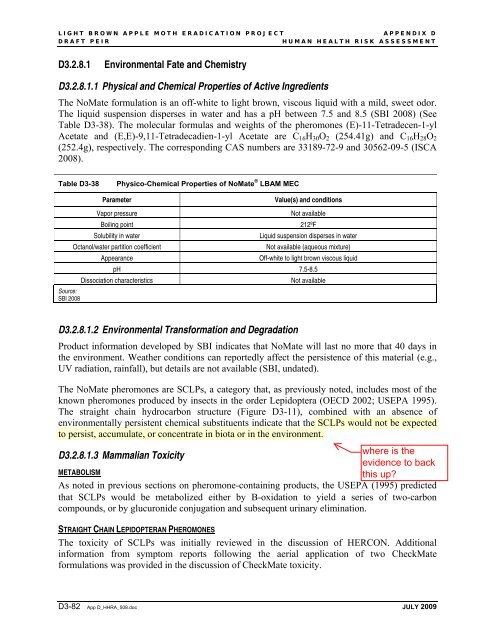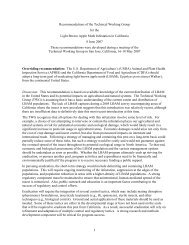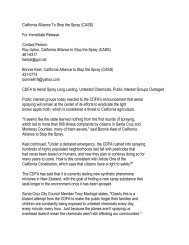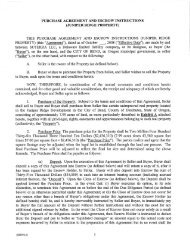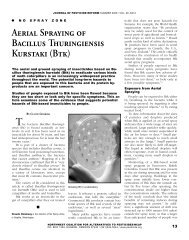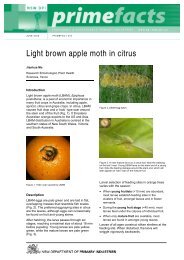Debunking Human Health Risk, APPENDIX D - LBAMspray.com
Debunking Human Health Risk, APPENDIX D - LBAMspray.com
Debunking Human Health Risk, APPENDIX D - LBAMspray.com
You also want an ePaper? Increase the reach of your titles
YUMPU automatically turns print PDFs into web optimized ePapers that Google loves.
LIGHT BROWN APPLE MOTH ERADICATION PROJECT<br />
<strong>APPENDIX</strong> D<br />
DRAFT PEIR<br />
HUMAN HEALTH RISK ASSESSMENT<br />
D3.2.8.1<br />
Environmental Fate and Chemistry<br />
D3.2.8.1.1 Physical and Chemical Properties of Active Ingredients<br />
The NoMate formulation is an off-white to light brown, viscous liquid with a mild, sweet odor.<br />
The liquid suspension disperses in water and has a pH between 7.5 and 8.5 (SBI 2008) (See<br />
Table D3-38). The molecular formulas and weights of the pheromones (E)-11-Tetradecen-1-yl<br />
Acetate and (E,E)-9,11-Tetradecadien-1-yl Acetate are C 16 H 30 O 2 (254.41g) and C 16 H 28 O 2<br />
(252.4g), respectively. The corresponding CAS numbers are 33189-72-9 and 30562-09-5 (ISCA<br />
2008).<br />
Table D3-38<br />
Physico-Chemical Properties of NoMate ® LBAM MEC<br />
Parameter<br />
Value(s) and conditions<br />
Source:<br />
SBI 2008<br />
Vapor pressure<br />
Not available<br />
Boiling point 212ºF<br />
Solubility in water<br />
Octanol/water partition coefficient<br />
Appearance<br />
Liquid suspension disperses in water<br />
Not available (aqueous mixture)<br />
Off-white to light brown viscous liquid<br />
pH 7.5-8.5<br />
Dissociation characteristics<br />
Not available<br />
D3.2.8.1.2 Environmental Transformation and Degradation<br />
Product information developed by SBI indicates that NoMate will last no more that 40 days in<br />
the environment. Weather conditions can reportedly affect the persistence of this material (e.g.,<br />
UV radiation, rainfall), but details are not available (SBI, undated).<br />
The NoMate pheromones are SCLPs, a category that, as previously noted, includes most of the<br />
known pheromones produced by insects in the order Lepidoptera (OECD 2002; USEPA 1995).<br />
The straight chain hydrocarbon structure (Figure D3-11), <strong>com</strong>bined with an absence of<br />
environmentally persistent chemical substituents indicate that the SCLPs would not be expected<br />
to persist, accumulate, or concentrate in biota or in the environment.<br />
D3.2.8.1.3 Mammalian Toxicity<br />
METABOLISM<br />
As noted in previous sections on pheromone-containing products, the USEPA (1995) predicted<br />
that SCLPs would be metabolized either by -oxidation to yield a series of two-carbon<br />
<strong>com</strong>pounds, or by glucuronide conjugation and subsequent urinary elimination.<br />
STRAIGHT CHAIN LEPIDOPTERAN PHEROMONES<br />
The toxicity of SCLPs was initially reviewed in the discussion of HERCON. Additional<br />
information from symptom reports following the aerial application of two CheckMate<br />
formulations was provided in the discussion of CheckMate toxicity.<br />
D3-82 App D_HHRA_508.doc JULY 2009


